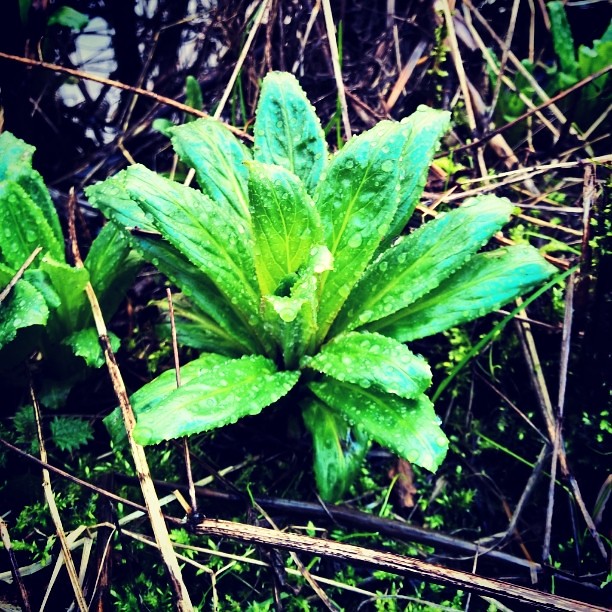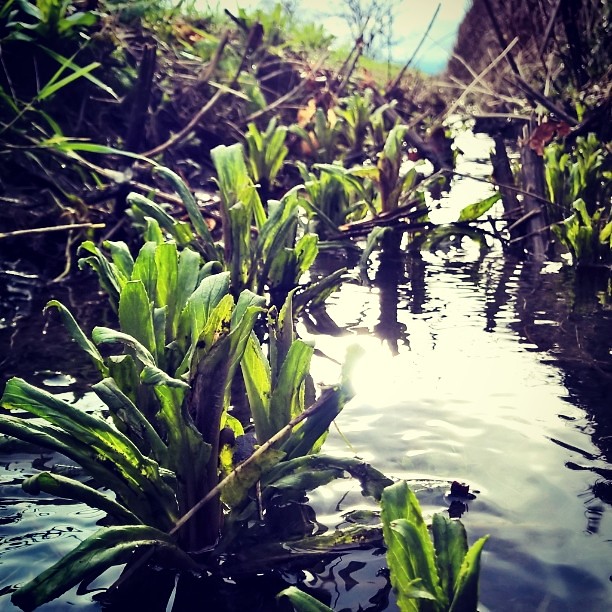More on vegetative plant identification. A useful stumbling block…
Attempt #3. Great Willowherb.
Keying out a dandelion and petty spurge using The Vegetative Key to the British Flora been reassuringly straight forward. I was feeling confident (cocky), so when I saw this growing in a wet ditch while out on a job I thought I’d have a bash at it…
That picture doesn’t show it very well but it was growing out of a water body. I had it in my mind that it was therefore going to be an aquatic plant. I don’t know my aquatic macrophytes very well so for all I knew it could be a young bog bean, marsh marigold etc.
The key took me through the following features (my descriptions below are not always direct quotes from the key):
- Leaves simple
- Leaf margin toothed
- Leaves alternate. This took me to KEY N
- It’s a herb
- Stipules absent
- Latex absent
- Leaves with hairs all simple or hairless
- Leaves with pinnate or palmate veins
- Petiole developing 1-2 hollows (Ranunculaceae) Key RAN. So now I’m thinking maybe it will be marsh marigold though if I’d looked at a photo I’d have realised straight away I was wrong, the leaves are totally different.
- Leaves lanc to ovate, not orb, unlobed but weakly toothed.
Here is where I knew I’d gone wrong. I spent some time trying to convince myself that that the leaves could be described as lanceolate to ovate but they just aren’t! They are obovate if anything. I was seduced by the weakly toothed bit making it hard to let it go. You brain likes to latch on to a bit that works in a plant description making you blind to all the other bits that don’t.
So there’s lesson one: Don’t ignore the descriptive elements you don’t like. If it’s wrong it’s wrong.
Next it all kinda fell apart as these things sometimes do when you get stuck. I misread an early line of text and convinced myself I should have answered yes to:
- Plant with submerged or floating leaves. Key E
Lesson two: Always read the key carefully and make sure you’ve understood it before moving on.
I started again and after a while trying and failing I admitted defeat and asked Miranda what it was. She took one look at it and said: “It’s great willowherb”. My heart sank. Oh yeah, I thought. “But it was growing in water” I said. “Yeah it often does” she said. “Oh”. I set about reverse engineering the key so I could see the route I should have taken.
It seemed to me that I would have needed a stem to use The Vegetative Key. I had another go using a young willowherb growing in my garden and again became stuck without a stem…
I consulted my favorite social media resources to check I was right. The BSBI on Twitter, and the ever obliging folk of Facebook’s Wild Flowers of Britain and Ireland group confirmed my suspicions. I asked Sarah whether she had any advice on getting further than ‘willowherb sp’ with plants this size. Her advice was: “I’d walk on by…willow herbs are a really tough group, they also hybridise, and doing them vegetatively is tough enough without doing rosettes.”
Lesson three: You need a stem to identify willowherbs using The Vegetative Key.
The next day I was working in North Wales. I’d been rummaging around in some woods and was on my way back to the van, parked in a lay-by on a country road. I looked into the roadside ditch as I walked along and saw lots of young great willowherb (Epilobium palustre) growing there…
Lesson four: Mistakes and failures can be every bit as useful as simple successes.
It took more than the key on its own to get there but knowing a species at every stage of it growth is so useful.
Thanks for reading. I hope you’ve found it useful or at least reassuring. Onward and upwards! More to follow…





I recognise much of this in my stumbling detective work associated with keying plants out when there are bits missing, making things up to at least take me somewhere, which turns out to be very obviously not it, then rummaging through loads of images on google via a long-winded description in the search box. But the satisfaction of occasionally keying something out right is so immensely satisfying, it’s all worth it. Thanks for sharing.
See, your adventures in vegetative plant ID is on the way to convincing me to get out and try it myself… Though I knew the above was great willow herb without the key as I went through something similar a few years ago – I assumed it was an aquatic plant and was immediately told otherwise… they are lessons that stick with you!
True, sometimes it feels like I learn almost exclusively from mistakes!